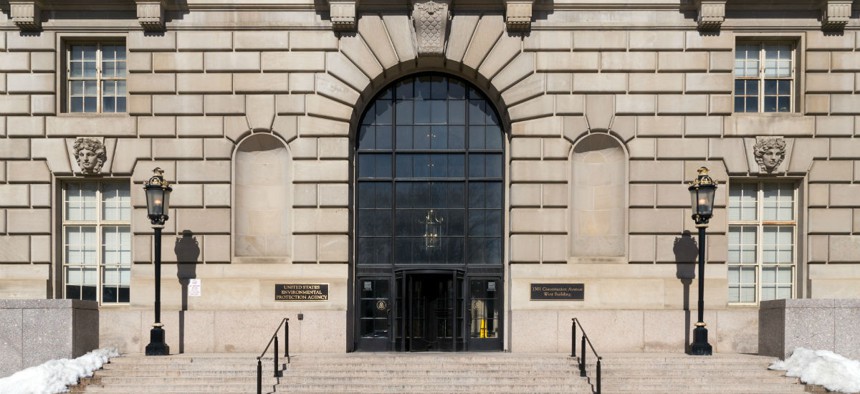EPA's Planned Budget Cuts Alarm Former Employees, Union
Agency’s support would be “the smallest since the mid-1970s,” analysis says.
The Trump administration’s long-planned cuts to the Environmental Protection Agency—proposed at 33.7 percent over enacted 2017 levels in the fiscal 2019 budget released on Feb. 12—would render the agency’s staff and support functions “the smallest since the mid-1970s when EPA was first established,” says an analysis released on Tuesday.
A nonpartisan coalition of former state and federal officials, scientists, lawyers and engineers working as the Environmental Protection Network warned that Trump’s cuts—more drastic than at any other agency—would leave EPA with its smallest workforce since 1984, “despite significantly increased congressionally mandated responsibilities since that date.”
Acknowledging that such steep cuts are not likely to be fully accepted by Congress, the group warned that “repeatedly advocating cuts of this magnitude normalizes the expectation that EPA’s budget should be reduced dramatically—on top of years of prior declines. This is an extreme benchmark against which smaller but still severe cuts appear ‘reasonable.’”
Circulated by the American Federation of Government Employees’ “Save the US EPA” campaign, the analysis said the “real impacts of these cuts will be significant and felt by families and communities across America. Trump would cut essential programs and staffing levels, making it increasingly difficult for federal and state environmental professionals to carry out their congressionally mandated responsibilities to protect public health and the natural environment.”
Some of the group’s highlights of the latest budget under Administrator Scott Pruitt:
- EPA’s workforce around the country would shrink from 14,824 in fiscal 2017 to 12,250 in fiscal 2019;
- EPA’s climate change programs and research would be eliminated, along with most voluntary climate programs;
- States would expect severe cuts to EPA funding for their partnerships that support local operating budgets; and,
- Fully 48 percent of science funding would be cut.
“Many forms of science, from toxicology to engineering, are interwoven into standard setting, reviews of new chemicals, disaster relief and Superfund cleanups,” the coalition argued. “Cuts to science funding are the most severe cuts proposed in the budget, and make a mockery of the goal adopted in EPA’s budget submission to ‘prioritize robust science.’ ”
Other changes, were the budget to be accepted on Capitol Hill, would eliminate most geographically based clean-up programs that affect areas such as the Great Lakes, the Chesapeake Bay and the Florida Keys.
Also on the chopping block are some tribal programs, permitting enforcement and chemical research—50 programs killed in all.
“Literally and figuratively, this is a scorched-earth budget that represents an all-out assault on clean air, water and land,” said Obama administration EPA Administrator Gina McCarthy in a statement cited by SAVE the US EPA, made up of the National Council of EPA Locals #238 and AFGE.
When the budget came out on Feb. 12, EPA leaders released a statement saying the $6.1 billion five-year budget supports its new strategic plan.
It laid out traditional mission themes of cleaning up contaminated land; improving America’s air quality; providing for clean and safe water; protecting water bodies of national significance; ensuring the safety of chemicals in the marketplace; and supporting state and tribal partners.
It also spoke of reducing and eliminating programs that “create unnecessary redundancies or those that have served their purpose and accomplished their mission”—for a total savings of $598.5 million.
In executing the governmentwide mandate for agency reorganization plans, the EPA budget “includes a series of projects focused on managing EPA programs more effectively and delivering results, including streamlining EPA’s permit review process, deploying a Lean Management System, and reducing unnecessary reporting burdens on the regulated community,” the agency summarized.
In a Feb. 20 internal message to staff, EPA Assistant Deputy Administrator and Chief of Operations Henry Darwin elaborated on the Lean Management System. The purpose is to “increase employee engagement across the agency,” he wrote to colleagues. “Employee engagement is more than just job satisfaction: it’s an emotional commitment to the work of EPA and its vital mission.”
He promised, beginning this spring, “weekly huddle meetings around visual management boards will provide teams—staff and management alike—the means to see how work is flowing and to identify ways of improving the work process.” Managers, Darwin continued, will be expected to run “short, daily, one-on-one check-ins with staff members to increase communication and, as always, solve small problems before they become big problems. I realize that the work we’ve done so far feels top down,” he added, “but that will soon change.”








